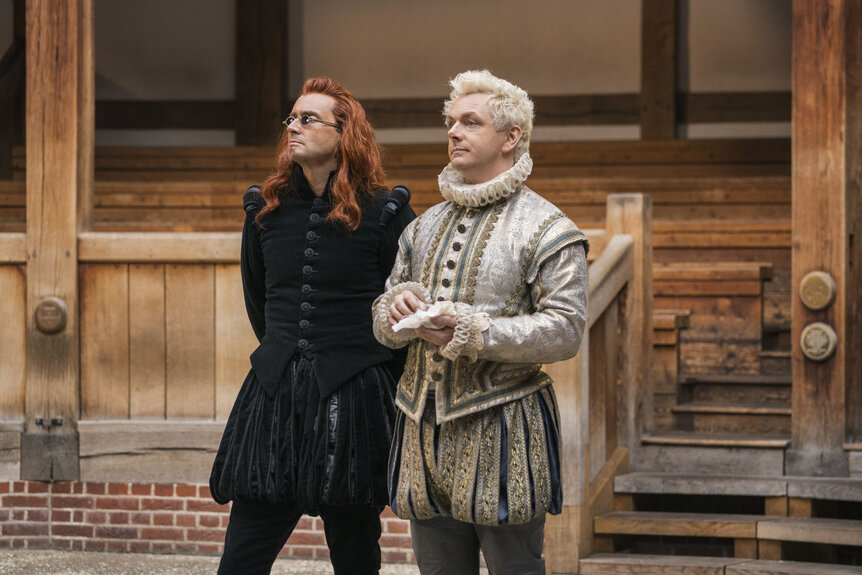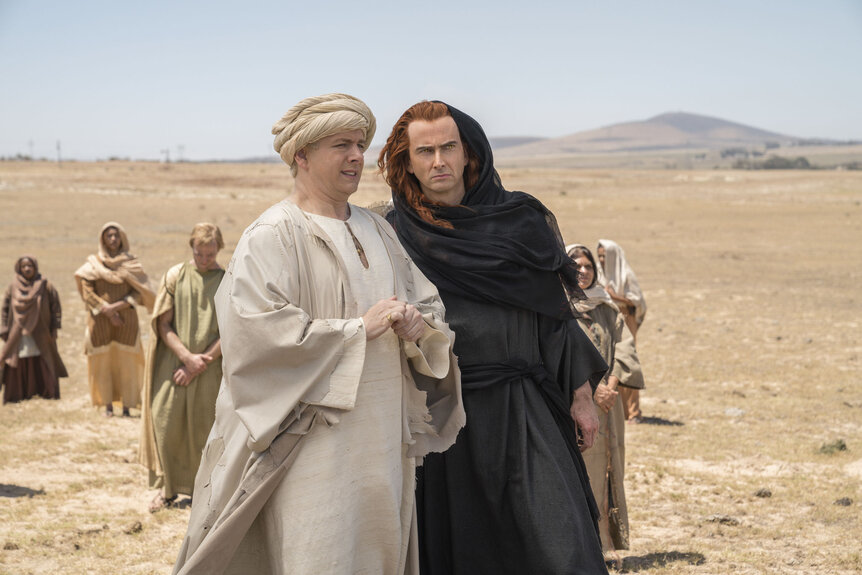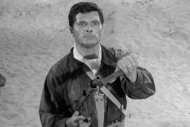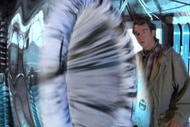Create a free profile to get unlimited access to exclusive videos, sweepstakes, and more!
How Terry Pratchett inspired Good Omens' heavenly, hellish title sequence

It's not every day that one gets to hear a death metal version of Buddy Holly's "Everyday," but that's exactly what happens when composer David Arnold plays a snippet of the unexpected cover. Arnold had the tune because it was initially going to be the theme song for Amazon's new series Good Omens. "If somebody had their head cast in metal and thrown into a furnace, maybe that's what it would sound like," Arnold cheerfully explains to SYFY WIRE.
Though Arnold eventually opted to go in another direction, there's a reason why he started with "Everyday." In the early '90s, Terry Pratchett, who co-authored the book the show is based on with Neil Gaiman, suggested that "Everyday" would be a great song for any possible adaptation. It would be a song that could recur throughout the whole story, opening the show and also running over the end credits in different incarnations, reflecting where they were in the story.
And so Arnold's first task was to create six different versions, none of which survived to the series, although the idea lives on in the TV spots. "There was a death metal version, a Shakespearean sonnet-y version, a Langley Schools Music Project kids' choir version, a Carmina Burana version," Arnold said. "So they do exist, and they're quite funny. The death metal one is hilarious, because it's the sweetest song in the world and fitting that into a head-banging version was quite the challenge. Here, I'll give you a blast," he said, as cacophonous music played. The trick, it seemed, was abandoning the melody and using a growling vocal style. "It's a cute idea."
As cute as it was, Arnold had another idea: Create an original theme and sustain it the way the Buddy Holly song would have, adapting it to the end of each episode. End the first episode "the way Queen would have done it," end the second episode with "an angry formal string quartet," end another with a "maniacal church organ," another "like a fairground carousel," and so on, to feel "like a nice scent that lingers."
Arnold wanted an original theme that the characters Aziraphale and Crowley could share, without it seeming like a punchline to a clever gag, and he decided upon a sweetly demonic waltz. "I wanted it to belong to both of them, to their relationship, and to the show, to have the light and the dark, the good and the bad, all at the same time," he said. "And what's interesting is that [Peter Anderson, who created the visuals for the opening] came up with the same thing, independently, for the main titles, as far as the attitude of the show is concerned. Stick them both together, and bingo!"
Like Arnold, Anderson's approach to designing the main titles was to take a few central concepts – in his case, the "grand gathering of troops from both sides leading up to the end of the world," and the platonic love between Aziraphale and Crowley – and combine it with everything. If Arnold's version of everything was every musical genre, Anderson's version was every design technique: illustration, 2D animation, 3D, CGI, and live action.
The different styles start at the very beginning, when Aziraphale and Crowley start their procession in a field of nothingness, and as they march along past strange landscapes, various characters — from nuns to spacemen to a brass band to the Horsepeople of the Apocalypse — join them. (Some of the characters are played by live actors who walked on a treadmill in costume against a green screen. Some are photograph collages. Some are pencil-drawn.)
As they walk, angelic miracles and demonic mischief affect the world, "little clues that you might not notice the first time you watch the sequence," Anderson said. An apple grows on a twisted tree. A red cactus flower turns black. When Crowley makes a spaceship spin out of control, Aziraphale saves the day by diverting it into the ocean and turning it into fish. At the bottom of the ocean floor, the procession continues (as plastic bags float overhead).
The escalators go up, and people are happy. The escalators go down, and people are not quite so pleased; one little character tries to go the other way. Until, ultimately, they come to the end of the world. Some continue to migrate upward, and some fall … or saunter vaguely downward. "You can read it one of two ways," Anderson said. "They're either going to Heaven or Hell, or they're choosing sides, to commence battle."
Take a close look at the characters, and every single face is either Aziraphale or Crowley, although some are disguised with beards, Mohawk haircuts, or blurred eyes. The point, Anderson said, was to illustrate how there is a little bit of good and evil in everyone. Their flat two-dimensional heads are on live-action bodies, "so you get this strange combination of something real and something that is otherworldly," Anderson said. Playing with elements of spatial perspective then makes it possible for scenes that shouldn't fit together to fit anyway – sandwiching elements of 2D and 3D to set Aziraphale's bookshop on fire.
"We wanted to make something new, that you hadn't seen before," Anderson said. "Arguably, that's impossible in the 21st century because everything's already been done. But we want you to believe in a world that is unbelievable."




























